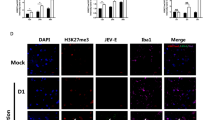Abstract
Rabies virus infection is an endemic disease which remains central to public health issues. The presence of epigenetics associated with the over-expression of B7-H1 in mice brain infected with rabies virus was investigated for the first time. A significant increase (p < 0.05) in mRNA level of B7-H1 as the disease progressed was observed. The percentage of methylated region was significantly (p < 0.05) higher in infected tissues relative to uninfected. DNA methyltransferase (DNMT) and histone acetylase (HAT) activities were also significantly (p < 0.05) higher in most infected brain tissues. HAT had a relatively higher proportion than DNMT when compared to the normal. Paradoxically, it can be inferred that the rabies virus uses epigenetic mechanisms as a means of manipulating host genes, as there was an increase in global DNMT and HAT activities with concomitant increase in B7-H1 promoter methylation and expression.





Similar content being viewed by others
References
Afreen S, Dermime S. The immunoinhibitory B7-H1 molecule as a potential target in cancer: killing many birds with one stone. Hematol Oncol Stem Cell Ther. 2014;7(1):1–17.
Albertini AAV, Ruigrok RWH, Blondel D. Rabies virus transcription and replication. Adv Virus Res. 2011;79:1–22.
Anastasiadi D, Codina AE, Piferrer F. Consistent inverse correlation between DNA methylation of the first intron and gene expression across tissues and species. Epigenet Chromatin. 2018;11:1–17.
Chopy D, et al. Ambivalent role of the innate immune response in rabies virus pathogenesis. J Virol. 2011;85(13):6657–68.
Deng R, et al. HDAC is indispensable for IFN-γ-induced B7-H1 expression in gastric cancer. Clin Epigenet. 2018;10(153):1–14.
Ding L, et al. PARP1 suppresses the transcription of PD-L1 by poly (ADP-ribosyl)ating STAT3. Cancer Immunol Res. 2019;7(1):136–49.
Goltz D, et al. PD-L1 (CD274) promoter methylation predicts survival in colorectal cancer patients. Oncoimmunology. 2017;6(1):1–4.
Gómez-Díaz E, Jordà M, Peinado MA, Rivero A. Epigenetics of host-pathogen interactions: the road ahead and the road behind. Public Libr Sci Pathog. 2012;8(11):1–10.
Halpern KB, Vana T, Walker MD. Paradoxical role of DNA methylation in activation of FoxA2 gene expression during endoderm development. J Biol Chem. 2014;289(34):23882–92.
Hattermann K, Mehdorn HM, Mentlein R, Schultka S, Held-Feindt J. A methylation-specific and SYBR-green-based quantitative polymerase chain reaction technique for O6-methylguanine DNA methyltransferase promoter methylation analysis. Anal Biochem. 2008;377(1):62–71.
Kurdistani SK, Tavazoie S, Grunstein M, Hall B, Angeles L. Mapping global histone acetylation patterns to gene expression. Cell. 2004;117:721–33.
Lafon M, et al. Detrimental contribution of the immuno-inhibitor B7-H1 to rabies virus encephalitis. J Immunol. 2008;180:7506–15.
Lafon M. Evasive strategies in rabies virus infection. Adv Virus Res. 2011;79:33–53.
Lu C, Liu K. Epigenetic regulation of PD-L1 expression and pancreatic cancer response to checkpoint immunotherapy. Transl Cancer Res. 2017;6(Suppl 3):652–4.
Masatani T, et al. Importance of rabies virus nucleoprotein in viral evasion of interferon response in the brain. Microbiol Immunol. 2013;57(7):511–7.
Meslin FX, Kaplan MM, Koprowski H. Laboratory techniques in rabies, 4th ed. Geneva, Switzerland: World Health Organization; 1996.
Miranda-Gonçalves V, Lameirinhas A, Henrique R, Jerónimo C. Metabolism and epigenetic interplay in cancer: regulation and putative therapeutic targets. Front Genet. 2018;9:427.
Otolorin RG, et al. A review on human deaths associated with rabies in Nigeria. J Vaccines Vaccin. 2015;06(01):1–6.
Poreba E, Broniarczyk JK, Gozdzicka-Jozefiak A. Epigenetic mechanisms in virus-induced tumorigenesis. Clin Epigenet. 2011;2(2):233–47.
Prosniak M, Hooper DC, Dietzschold B, Koprowski H. Effect of rabies virus infection on gene expression in mouse brain. Proc. Nat. Acad. Sci. 2001;98(5):2758-63.
Reddy MA, Natarajan R. Recent developments in epigenetics of acute and chronic kidney diseases. Int Soc Nephrol. 2015;88(2):250–61.
Srithayakumar V, Sribalachandran H, Rosatte R, Nadin-Davis SA, Kyle CJ. Innate immune responses in raccoons after raccoon rabies virus infection. J Gen Virol. 2014;95(Pt 1):16–25.
Steele N, Finn P, Brown R, Plumb JA. Combined inhibition of DNA methylation and histone acetylation enhances gene re-expression and drug sensitivity in vivo. Br J Cancer. 2009;100:758–63.
Ubol S, Kasisith J, Pitidhammabhorn D, Tepsumethanol V. Screening of pro-apoptotic genes upregulated in an experimental street rabies virus-infected neonatal mouse brain. Microbiol Immunol. 2005;49(5):423–31.
World Health Organization. World Malaria Report 2013. 2013.
Wu C. Chromatin remodeling and the control of gene expression. J Biol Chem. 1997;272(45):28171–4.
Acknowledgements
We wish to thank and appreciate Africa Center of Excellence for Neglected Tropical Diseases and Forensic Biotechnology, (ACENTDFB) Ahmadu Bello University (ABU), Zaria for funding this important project. We also wish to acknowledge Dr. David Dantong of the Department of Microbiology, Faculty of Veterinary Medicine, University of Abuja, Nigeria for the help he has rendered in getting us CVS and SRV strains of the rabies virus used in this study.
Author information
Authors and Affiliations
Contributions
Conception: AM, CEO and GSNK; Design: AM, CEO, MMA and GSNK; Execution: CEO, AM, JCA; Interpretation: AM, CEO, GSNK, JKPK; Writing and Proof reading: CEO, AM, GSNK, MMA, AM, JCA, JKPK.
Corresponding author
Ethics declarations
Conflict of interest
The authors declare that they have no conflict of interest..
Human and animal rights
Animal housing and experimental protocols were performed according to the guidelines of the Nigerian council on Animal Care with the approval of the Ahmadu Bello University animal care committee.
Additional information
Publisher's Note
Springer Nature remains neutral with regard to jurisdictional claims in published maps and institutional affiliations.
Rights and permissions
About this article
Cite this article
Ojedapo, C.E., Muhammad, A., Kia, G.S.N. et al. Rabies virus infection in mice up-regulates B7-H1 via epigenetic modifications. VirusDis. 31, 388–394 (2020). https://doi.org/10.1007/s13337-020-00588-w
Received:
Accepted:
Published:
Issue Date:
DOI: https://doi.org/10.1007/s13337-020-00588-w




